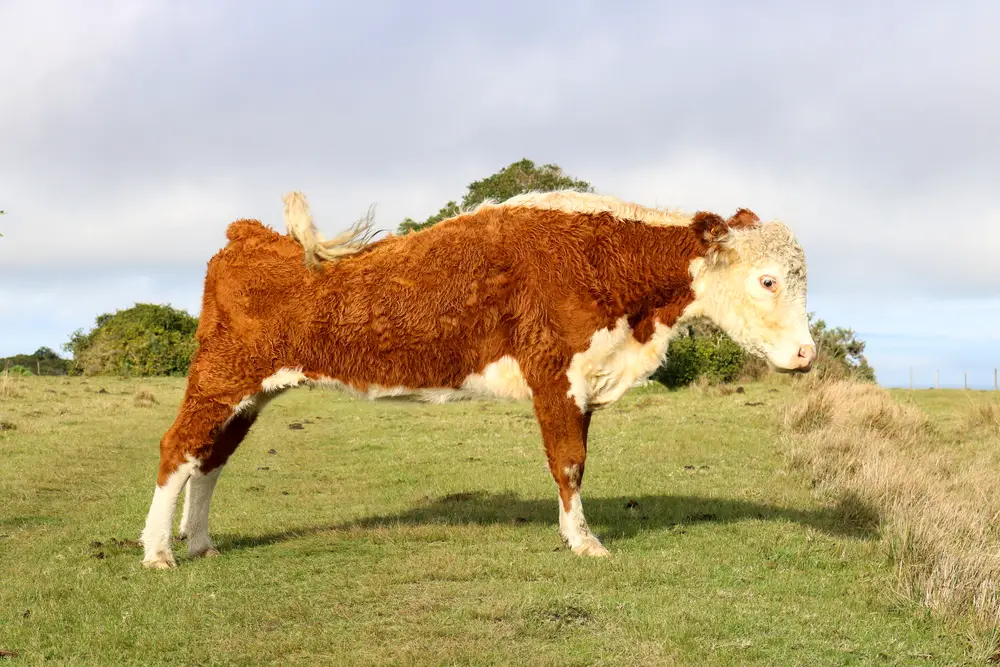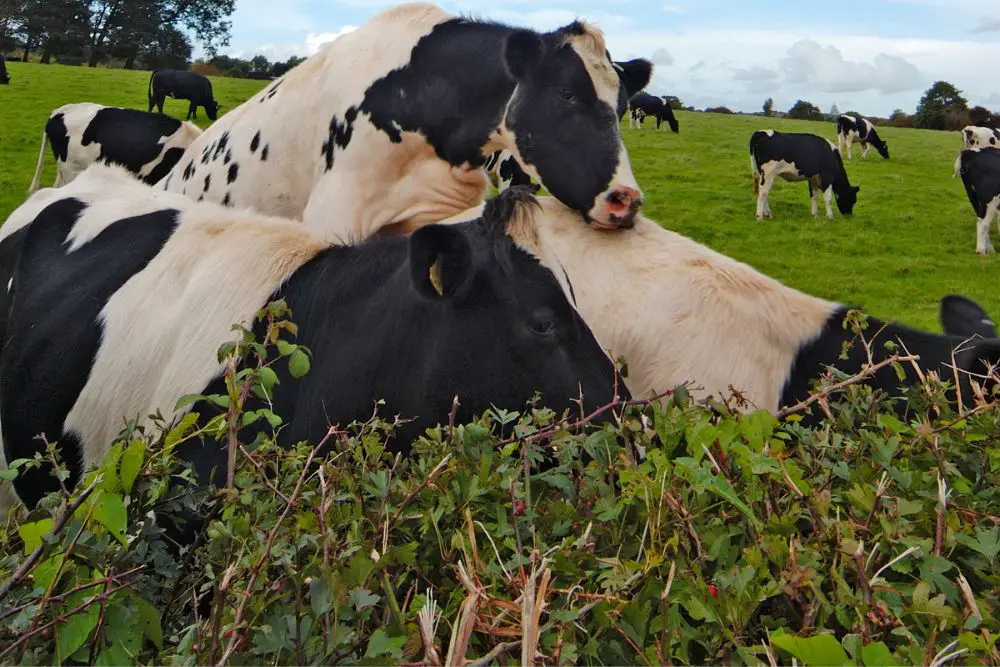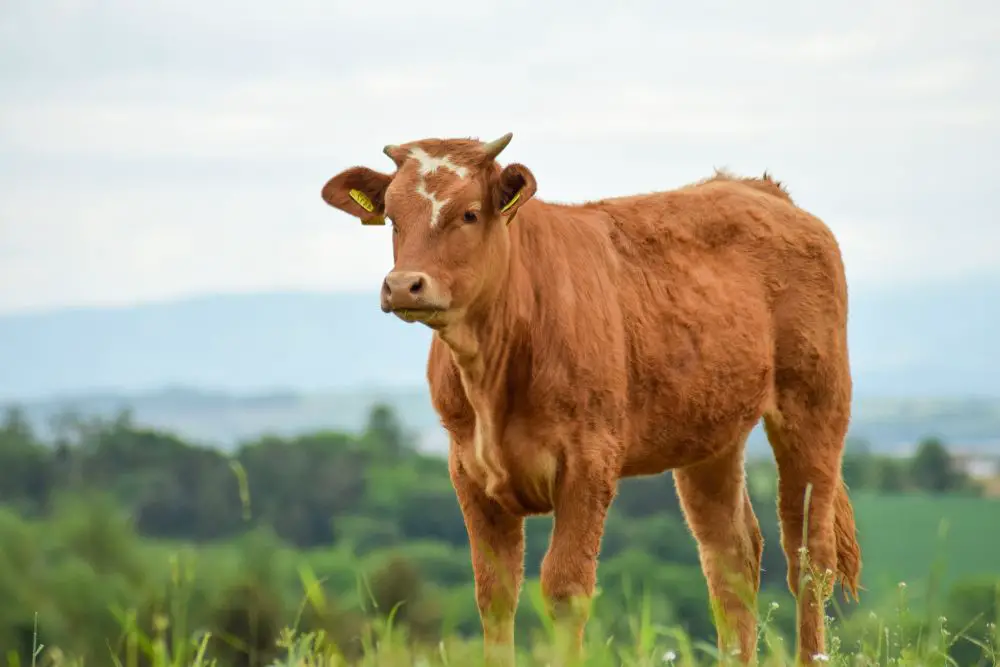Cattle are “aseasonally polyestrous” and go into heat (or “cycle”) at any time during the year. There is no evidence to prove that cattle are more or less fertile at any single time of the year, and, as such, they don’t have a defined breeding season.
In this guide, we’ll help you better understand how your cattle breeding hormones change throughout the year.
Table of Contents
The Estrous Cycle
Estrogen and progesterone are the two main pregnancy hormones in a cow’s estrous cycle. Estrogen, produced in the ovary by the follicle (the source of the egg), is the leading cause of “heat” or estrous behavior. Progesterone is a pregnancy hormone that the corpus luteum produces in the ovary.
The definition of a cow is a female beef or dairy animal that has calved at least once. Cows go into heat when estrogen levels rise, and progesterone levels fall. This change is called a heat cycle and happens every 21 days, although the range can range from 18 to 28 days.
It is abnormal for cattle to be in heat any longer than this. Heifers (a young female beef or dairy animal that has not yet birthed a calf) tend to have a tighter spread of days, but not by much.
Estrus and Estrous
A non-gestating cow will continue cycling between an estrogen-dominant and progesterone-dominant state until insemination occurs at the appropriate time between ovulation and estrus. This cycling will not happen to a pre-pubescent one or one that has just had a calf.
The words “estrus” and “estrous” look and sound very similar, but they do have different meanings:
| Estrus | A noun and describes the short time a cow or heifer is sexually receptive and will stand to be mounted |
| Estrous | an adjective meaning “in-heat.” You would use it to talk about actions connected with estruses, such as estrous behavior or the estrous cycle (the time between one estrus and another) |
Puberty and Calving
The age heifers reach puberty depends on their breed, health, nutrition, and genetics. Heavier ones begin their cycle sooner than lighter ones due mainly to their growth rate. Consequently, they should display a progressive and substantial weight gain during rearing if farmers are to take full advantage of their fertility.
The first time a heifer has an estrus or goes into heat is at the onset of puberty. Properly-nourished beef heifers typically reach puberty between 9 and 12 months, whereas dairy heifers take about 3 months longer. The Brahman breed of cattle can take up to 2 years!
Pubescent heifers then start to have continuous estrous cycles every 3 weeks, with the average range being 18 to 24 days.
Cycling and Impregnation
The average age for a cow to calve is 2 years old. With a standard gestation period of just over 9 months, you should look towards getting your heifers pregnant at 15 to 16 months old.
Cycling must start at a year to 13 months for this to happen. Timing is crucial because a heifer will conceive much more quickly if she has had 2 or 3 cycles before insemination.
Heifers must reach half their projected body weight after a year and then be able to increase by a further 10 percent over the following 3 months. A heifer breeder’s business can succeed or fail depending on how they manage their fertility program and how conscientious they are with weight targeting and recording.
Standing Heat – The Tell-Tale Signs
The next step is recognizing that heifers and cows are in standing heat. Please bear in mind that the first instances of ovulation in beef and dairy are usually “silent,” i.e., a lack of “behavioral estrus” means there is no obvious indication that the cow is in heat.
The most obvious sign a cow is in standing heat is her body language. She will be standing in such a way as to provoke a bull or herd mates into mounting her, with an archedback and raised tail. Sometimes, in-heat cows will mount one another, stand with their head in an upright or downward position and curl their lips.

The herd will display a general restlessness with constant mooing, bellowing, and grunting. Cows might follow each other, sniff genitalia, and indulge in chin resting on fellow herd members. Some cows may wander off on their own.
Feeding and Urination Patterns
The constant mounting and being mounted means a cow’s flanks will be muddy, and the tail head will show signs of matting or ruffling. Feeding will be affected as cows eat less while in standing heat. Standard urination patterns also change as cows might urinate less frequently than usual.
Vulvae redden, swell and will show a clear mucus discharge during the in-heat period. After the standing heat has finished, there is a bloody discharge from the vulva.
Heat Detection
Despite all these visual signs of standing heat, many in-heat cattle go undetected because they display no such indication. Consequently, it is vital to be able to detect a cow in estrus or standing heat.
As stated above, a typical non-pregnant cow or heifer that is sexually mature will go into standing heat every three weeks. A farmer can take advantage of special heat synchronization procedures to guarantee this.
Standing heat is the point in a cow’s estrus cycle when she displays a willingness for a bull or other herd mates to mount her. Standing heat usually lasts between 12 and 18 hours and is the only indication that cows are ovulating and ready for natural or artificial insemination.

The most effective way of heat detection is to check every morning and evening. In areas of high temperature, morning heat detection should be carried out just after dawn before the heat can reduce mounting activity.
Measuring differences in temperature between the cervix and the rectum is also essential when calculating the state of standing heat in dairy cows.
Heat detection collars or applying brightly-colored chalk to tail heads can be a very effective way of telling if a cow is in heat or not. Mounting bulls will “scuff off” the chalk when mounting and indicate the cow is in heat.
A proven way of improving heat detection is to use “teaser” bulls. Teaser bulls are vasectomized but not castrated, so they still produce testosterone and can, therefore, detect cows in heat.
The teaser bull marks the cow in heat by mounting and marking her with a paintball attached to his chin.
Post-Partum
Post calving, the point at which a cow will start its next estrous cycle depends on its physical and mental health, body weight, and nutrition. Follicular activity (such as estrogen creation) can resume after fewer than 10 days if the cow displays an increase in the production of a transient follicle-stimulating hormone within 5 days of birthing.
Well-nourished dairy cattle would normally recommence ovulation about 2 weeks after calving. A beef suckler cow would take approximately 30 days. Female beef cattle with poor physical characteristics might not ovulate for up to 100 days.
Ovulation can take time to re-establish itself as suckling, decreased physical condition after providing the gestating calf with adequate nutrition, and the exertion of calving can suppress the luteinizing hormone pulses that spark ovulation.
Placental membrane retention and uterine infections can also play their part in prolonged delays in ovulation. Dystocia or difficulties with labor, particularly common in Holsteins, is a further complication.
To sum up, the fundamental requirement of an effective breeding program is that post-partum cows should resume ovulation in the shortest time frame possible. To achieve this, they should be in absolute peak physical condition, pre-partum.
Physical Deterioration
Poor health, decreased physical condition just before and during calving, and contracting a disease around the birth delay a prompt return to regular cycling. Another major factor is a reduction in body weight, as already noted in heifers reaching puberty.
Cows that lose weight and condition after giving birth tend to have irregular cycles and are less likely to conceive. Keeping on top of your cows’ physical well-being by using body condition scoring (BCS), for example, is crucial if your early-lactating cows (cows of four months or younger) are to achieve a high level of fertility.

First-lactation cows should be a priority as they have to make many adjustments in a short time, such as being milked for the first time and facing breeding bulls, while also having to show good daily weight gain. Cows with optimum fat reserves have a greater propensity to a high body condition score than cows with insufficient or surplus ones.
Body Condition Scoring
It’s best to target a mean condition score of 2.5 for cows at the calving stage. If your cows are falling below that score, the most economically viable way to improve their BCS is to increase their quantities of feed supplements in the later stages of lactation.
After calving, it is still essential to continue BCS tracking. A drop-off of less than one should be the desired target.
Milk yield has a high correlation with a low BCS. Cows producing high quantities of milk have a dramatically reduced chance of conceiving. Consequently, it may be worth waiting and concentrating on restoring their physical condition until they are ready to undergo further servicing attempts.
When To Artificially Inseminate
When artificially inseminating cattle, you need to plan a suitable heat synchronization procedure and have access to an effective A.I. sire.
To undertake a successful conception, the best practice is to commence insemination no more than 12 hours after detecting the cow is in standing heat. Repeat the A.I. 12 hours later if the cows still show standing heat after the first attempt.
Male bovine sperm stays fertile for between 24 and 30 hours from insemination. The egg the cow ovulates, or the ova, has a productive life of only 8 to 10 hours, while a typical cow will ovulate about 24 to 32 hours after standing heat commences.
You might use sexed semen with XY- or XX-bearing sperm if you wish to produce either male or female progeny. In this case, repeating the process after only four to six hours is advisable. Waiting this length of time is also good practice for cows with observed standing heat.
Estrous Cycles in Cattle
Grasping how the estrous cycle works in cows and heifers can help cattle operations overcome problems with cow reproduction. Understanding how to use a drug regimen to synchronize and control their cattle’s estrous cycles will also help.
The estrous cycle in cattle is complicated and controlled by several organs and hormones.
The Follicular Phase
A follicle is a small sac full of fluid in the ovaries which contains an “ovum” or an egg and estrogen-producing cells. A heifer or cow usually develops between two and three ovarian follicles or “waves” during one estrous cycle.
One follicle per wave becomes a dominant one. This dominant follicle does not ovulate in the early stages of the estrous cycle when progesterone levels are high. It regresses instead and permits the release of the second wave of follicles.
When progesterone levels drop, the final wave takes place. However, this time the dominant follicle does not regress but grows larger and produces increasing quantities of estrogen.
Ovulation and Estrus
The large amounts of estrogen the dominant follicle produces are responsible for the cow or heifer demonstrating signs of estrus.
She is now sexually receptive and will go into “standing heat.” As stated earlier, there are other clear indications of her estrus, such as the clear mucous that the vagina discharges.
High estrogen levels also cause the hypothalamus to produce a gonadotropin-releasing hormone (GnRH) just before ovulation. GnRH makes the pituitary gland secrete two other hormones: the follicle-stimulating hormone (FSH) and the luteinizing hormone (LH). These hormones control the follicles in the ovaries.
FSH is released during and post-estrus and provokes a new wave of ovarian follicles. LH makes the dominant ovarian follicle rupture about 24 to 32 hours later, and ovulation occurs as the egg is released. The change from the follicular phase to the luteal stage is now complete.
The Luteal Phase
In the luteal phase, the remains of the ruptured follicle become the corpus luteum and produce progesterone, a steroid hormone necessary to support a pregnancy once the egg becomes fertilized. The corpus luteum reaches its maximum level of progesterone production around day 10.
More follicles grow and regress, but this time a dominant follicle will not rupture until there is a drop in progesterone in the next follicular phase.
Pregnancy
If a cow or heifer becomes pregnant, the corpus luteum will still produce high levels of progesterone, but the presence of an embryo means the uterus stops creating prostaglandin F2-alpha.
The high progesterone levels prevent the cow or heifer from cycling, so she stops ovulating and will not go into heat. The embryo now develops into a fetus.
A bovine gestation (the development of an embryo and then fetus in a womb between conception and calving) takes around 283 days.
Healthy heifers that calve at two years have higher lifetime productivity levels than heifers that calve later in life. For that to happen, the heifer must become pregnant at 14 to 15 months.
Non-Pregnancy
If the egg fails to fertilize or the embryo doesn’t develop, the uterus will produce prostaglandin F2-alpha around day 16 to 20 in the estrous cycle. Prostaglandin F2-alpha causes a fall in progesterone levels due to luteolysis as the corpus luteum cell dies.
The scarcity of progesterone means the final follicle wave can produce a dominant ovarian follicle. This follicle will create sufficient estrogen to provoke estrus and the next estrous cycle to start.
Cycling Detection
“Cycling” is when a cow or heifer’s estrous cycle and estrous behavior are functioning normally. If a cow or heifer is not ovulating, in heat, or pregnant, she’s not cycling. This state is known as “anestrus” or “acyclic.”
Cows or heifers will usually be anestrus for a short while after calving. Reproductive tract infections or ovarian cysts can also stop cycling.
“Silent heat” is when a cow or heifer is cycling but shows all the signs of being anestrus and does not demonstrate any signs of heat.
